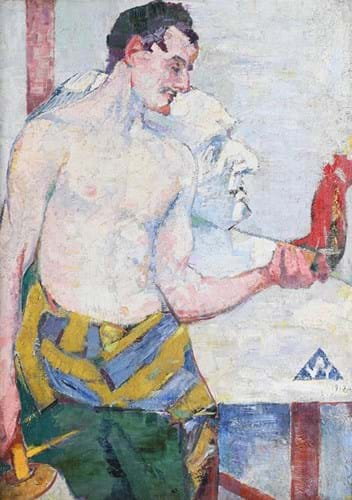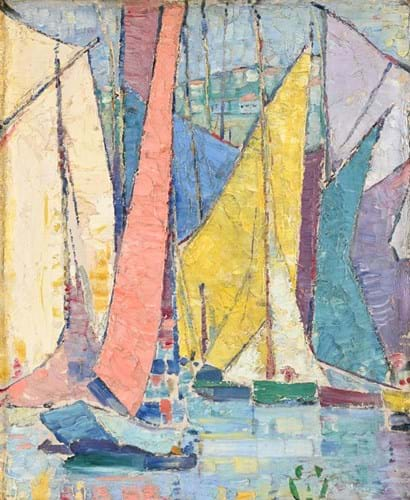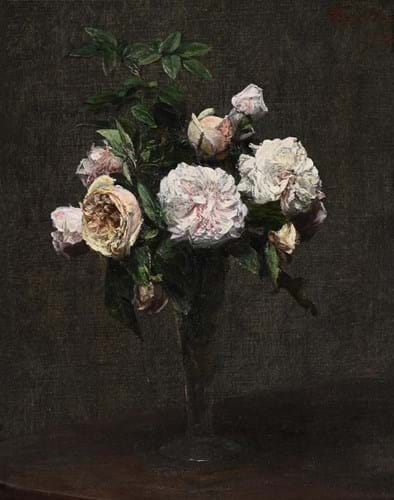
An original sketch for The hearing of the appeal of Sir Roger Casement by John Lavery, £124,000 at Dreweatts.
The overall total at the auction on March 13 was £1.6m (including buyers premium) from 240 lots. Dreweatts’ head of sale Francesca Whitham said the results showed “a buoyant market with competitive bidding from across the globe”.
Among the highlights was an original on-the-spot sketch for Sir John Lavery’s (1856-1941) The Hearing of the Appeal of Sir Roger Casement – a monumental painting now in the UK government collection which has been on long-term loan to King’s Inns, the Dublin Inns of Court, since 1951.
Casement’s trial in June 1916 remains a controversial event. The former British diplomat turned Irish nationalist was arrested for his part in the events leading up to the Easter Rising in Ireland. He was convicted of treason under a 14th century statute and hanged in Pentonville Prison following a failed appeal.
Lavery, the Belfast-born artist who became a leading society portrait painter, was commissioned by the presiding judge, Sir Charles John Darling, to record the court proceedings of the appeal.
The hearing took place over two days in July 1916 at the Court of Criminal Appeal in London. Lavery kept his paints hidden from view as he and his wife Hazel sat in the witness box as he worked on the sketch. The 10 x 15in (25.5 x 38cm) oil on canvas-board was then worked up into the large-scale finished painting over many years in Lavery’s studio (containing portraits of 40 figures it was a major undertaking which the artist took until 1931 to finally complete).
The sketch shows the five judges to the left with Casement sitting in the dock directly opposite the viewer. It was kept in Darling’s collection until he died and came to auction from a descendant. Indeed it was not the only work by Lavery that the judge owned – he had also commissioned Lavery to paint his wife, daughter and himself earlier in his career.
The sketch attracted plenty of interest including in the Irish press and Dreweatts confirmed that it received interest from institutions in the lead up to the auction.
Estimated at £15,000-25,000, it drew a prolonged competition on the day with bidding from both Ireland and the UK. It came down to a battle between an online bidder from Ireland and a telephone line before it was eventually knocked down to the former at £124,000.
The price was one of the largest sums ever paid for a small Lavery painting – the highest for a similarly-sized work at auction remains the £150,000 for a study for a racing picture titled Ascot in Rain that sold at Bonhams in 2018.
Wolmark record
Elsewhere at the Newbury sale, a major record came for Alfred Wolmark (1877-1961) when a depiction of the artist and sculptor Henri Gaudier-Brzeska (1891-1915) dramatically overshot a £4000-6000 estimate and was knocked down at £140,000.
The price surpassed the previous auction high of £55,000 for the artist’s large 1907 canvas The Disputation that sold at Sotheby’s in 2012.
Born in Poland, Wolmark emigrated to London and studied at the Royal Academy Schools in the 1890s. He became close friends with Gaudier-Brzeska and the two artists made portraits of one another. In fact, the 3ft 11in x 2ft 9in (1.19m x 84cm) oil on canvas showed Gaudier-Brzeska working on the well known bust of Wolmark himself.
Gaudier-Brzeska’s died in the trenches during the First World War and his plaster portrait of Wolmark was later posthumously cast in bronze in an edition of six between 1954-60.
The portrait showing the bare-chested Gaudier-Brzeska dated from 1912 and was signed with Wolmark’s monogram. It was part of the private collection of May Platini, the artist's niece, from whom it had been purchased by the vendor here.
One of the artist’s brighter experiments with Post-Impressionism, the picture had featured in the Rediscovering Wolmark: A Pioneer of British Modernism at the Ben Uri Gallery in London in 2004-5.
An attractive proposition with a lot going for it commercially, the painting always looked likely to surpass its attractive estimate. But, with strong bidding on the phone and online from both UK and overseas, a UK dealer had to go well into six-figures to secure it.
Another work from the same source that also featured in the Ben Uri exhibition was Wolmark’s Boats, Concarneau, an oil on canvas-board of boats with colourful sails from 1911. Another lot that overshot predictions, in this case a guide of £2000-3000, it was knocked down at £21,000.
Still life in demand
The top selling lot of the day was a trademark still life by Henri Fantin-Latour (1836-1904). Titled Roses Thé, the 17¼ x 15½in (44 x 40cm) signed oil on canvas from 1874 had good provenance having been purchased by the vendor’s family from Glasgow dealer Reid & Lefevre some time ago.
Its authenticity was confirmed by Paris gallery Brame & Lorenceau and it will be included in its forthcoming catalogue raisonné of the artist's paintings and pastels.
With delicate handling and customary attention to detail, the picture ticked the boxes that buyers look for when it comes to Fantin-Latour. It duly flew over its £50,000-70,000 estimate and was eventually knocked down at £190,000 to an online buyer.








